Understanding Air Inlet Windows for Enhanced Ventilation and Energy Efficiency
Nov . 09, 2024 05:38 Back to list
Understanding Air Inlet Windows for Enhanced Ventilation and Energy Efficiency
The Importance of Air Inlet Windows in Modern Architecture
In the realm of modern architecture and building design, the utilization of air inlet windows has become a pivotal aspect of creating energy-efficient and well-ventilated spaces. As cities grow denser and environmental concerns escalate, the role of air inlet windows can no longer be underestimated. This article explores their importance, functionality, and the advantages they bring to contemporary buildings.
What Are Air Inlet Windows?
Air inlet windows are specially designed openings in a building's envelope that allow for the controlled entry of outside air. These windows can be automatic or manual and are typically used in conjunction with exhaust systems to promote adequate air circulation within indoor environments. By facilitating fresh air intake, they help maintain a balanced atmosphere, essential for occupant comfort and health.
Enhancing Ventilation and Air Quality
One of the primary benefits of air inlet windows is their contribution to indoor air quality. With the growing awareness of the health risks associated with poor air quality, these windows provide a natural solution. They allow for the influx of fresh air, diluting indoor pollutants such as volatile organic compounds (VOCs), dust, and allergens. This is particularly crucial in spaces where high levels of carbon dioxide can accumulate, such as classrooms, offices, and residential homes.
Incorporating air inlet windows encourages cross-ventilation—an efficient method of cooling buildings without relying heavily on mechanical systems. By allowing cooler air to enter from one side of the building while hot air escapes from the other, air inlet windows create a comfortable living environment. This passive cooling strategy not only saves energy but also reduces the building's carbon footprint.
Energy Efficiency and Sustainability
air inlet window

As sustainability takes center stage in architectural design, air inlet windows contribute significantly to energy conservation. Traditional mechanical ventilation systems consume substantial amounts of energy, whereas naturally ventilated spaces with air inlet windows can reduce reliance on heating and cooling systems. This energy efficiency can lead to significant cost savings over time, benefiting both building owners and occupants.
Additionally, integrating air inlet windows into a building's design can qualify it for various green certifications, such as LEED (Leadership in Energy and Environmental Design). This acknowledgment not only enhances a building’s marketability but also reflects a commitment to sustainable practices.
Design Flexibility and Aesthetics
Air inlet windows are not merely functional; they also offer architects and designers a great deal of creative flexibility. They come in various styles, sizes, and operating mechanisms, allowing them to seamlessly blend with different architectural aesthetics. Whether integrated into a modern high-rise or a traditional home, these windows can enhance visual appeal while serving their core purpose.
Moreover, the placement and orientation of air inlet windows can be strategically planned to maximize natural light, thus creating more welcoming indoor environments. When designed effectively, they can become a focal point of a room, merging beauty with utility.
Conclusion
In summary, air inlet windows represent a vital component of modern architectural design that addresses the growing demands for improved air quality, energy efficiency, and sustainability. As urban environments become increasingly complex and populations expand, the need for such innovative solutions is paramount.
By leveraging natural ventilation through the inclusion of air inlet windows, architects and builders can create healthier indoor spaces that promote well-being while also respecting our planet. As we move towards a more sustainable future, these windows exemplify how thoughtful design can harmonize functionality with environmental stewardship. Their role in promoting both architectural beauty and ecological responsibility cannot be overlooked, making them an essential feature of contemporary building practices.
-
Hot Sale 24 & 18 Door Rabbit Cages - Premium Breeding Solutions
NewsJul.25,2025
-
Automatic Feeding Line System Pan Feeder Nipple Drinker - Anping County Yize Metal Products Co., Ltd.
NewsJul.21,2025
-
Automatic Feeding Line System Pan Feeder Nipple Drinker - Anping County Yize Metal Products Co., Ltd.
NewsJul.21,2025
-
Automatic Feeding Line System - Anping Yize | Precision & Nipple
NewsJul.21,2025
-
Automatic Feeding Line System - Anping Yize | Precision & Nipple
NewsJul.21,2025
-
Automatic Feeding Line System-Anping County Yize Metal Products Co., Ltd.|Efficient Feed Distribution&Customized Animal Farming Solutions
NewsJul.21,2025






